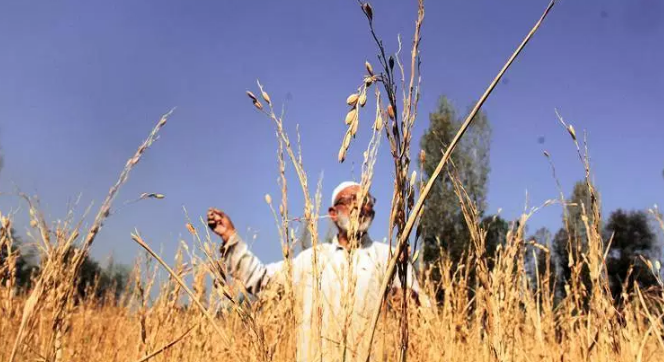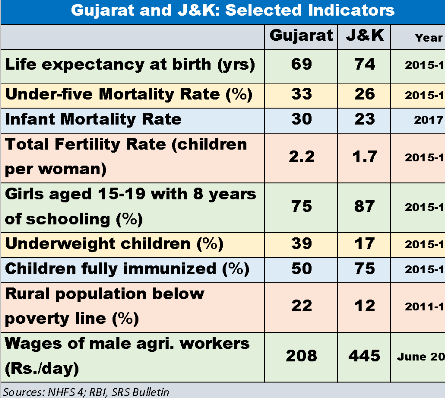Land Reform and Development in J&K

Image Courtesy: The Indian Express
The Government of India recently abrogated the special status enjoyed by the erstwhile state of Jammu and Kashmir under Article 370 of the Indian Constitution. One of the main raison d’etre cited by Home Minister Amit Shah while introducing the resolution in the Rajya Sabha on August 5 was that Article 370 has hampered the development of the people of Jammu and Kashmir. Soon, this became a popular opinion.
Criticising this widely popular move, renowned economist and academic Jean Dreze voiced his dissent arguing, “It is not correct to say that Kashmir is a backward state, therefore, it was a must to remove Article-370. Of course, there are economic problems but living standard is actually quite good, nutrition is much better in Kashmir than Gujarat.” Dreze argues that Jammu and Kashmir is, in fact, more developed than many of the other Indian states. He also makes a comparative analysis between the human development indicators of Jammu and Kashmir and Gujarat.

Interestingly, Dreze attributes the better performance of Jammu and Kashmir to the extensive land reforms that were carried out by the National Conference government in the 1950s and contends that it was, in fact, Article 370 that made these reforms possible. He says, “Because of Article-370, Jammu and Kashmir has its own constitution and this constitution allowed distribution of land which the Constitution of India would not have allowed. I think it played an important part in reducing poverty and in laying the foundation of a relatively egalitarian economy in rural areas.”
Also read: Kashmir: Land Reforms, Low Rural Poverty and Role of Article 370
Sharply critical of the government’s move, former finance minister of Jammu and Kashmir, Haseeb A. Drabu writes, “For the people of J&K, the biggest benefit of the state having greater legislative latitude under Article 370 has been the radical restructuring of agrarian relations. It was the first state in India, much before the communist government in Kerala, to carry out non-compensatory land reforms.”
Land reforms in Jammu and Kashmir
Land reforms in Jammu and Kashmir constituted a part of a spate of reforms, including health, education and agrarian reforms, introduced by the National Conference government between 1948 and 1976. Two major legislations through which these reforms were affected were – the Big Landed Estates Abolition Act, 1950 and the Jammu and Kashmir Agrarian Reforms Act, 1976. Under the Big Landed Estates Abolition Act, the upper limit for landholding was reduced to 22.75 acres in 1950, which was further reduced to 12.50 acres through the Agrarian Reforms Act, 1976. All land in excess to the ceiling was expropriated by the state and was then transferred to the actual tillers. The decision on compensation was taken later in 1951 by the Constituent Assembly of the state which decided against paying any compensation to landlords. It was their belief that the system that resulted in this kind of stark disparity in land ownership was deeply exploitative and parasitic and neither the state nor the beneficiaries of the reform owed compensation to the landlords who had benefitted from this exploitative structure for centuries.
These reforms, as first envisioned and articulated by the leaders of the National Conference, were introduced by them in the Naya Kashmir (New Kashmir) Manifesto in 1944. The basic principles informing these land reforms – ‘abolition of intermediaries’ and ‘land to the tiller’ – were proposed in Naya Kashmir. Jammu and Kashmir was the only state in independent India that refused compensation to landlords whose lands were expropriated by the state. These reforms were further supplemented with elaborate tenancy reforms. (M. Moza, Politics of Land Reforms in Jammu and Kashmir State, 1980)
Naya Kashmir was launched by the leaders of the National Conference in 1944. This document laid down a comprehensive plan for socio-economic, political, and cultural reconstruction of the state of Jammu and Kashmir. Drawing inspiration from the Soviet model, Sheikh Abdullah declared the vision that was being laid down for the newly emerging state would be socialist. He emphasised that real freedom is possible only after economic emancipation of the people. With this leaning, he resolved to build the foundation of democracy in the state on the bedrock of economic equality. (S.M. Abdullah, New Kashmir, 1944)
Also read: Kashmir Not Happy with Abrogation of Article 370 as Media and Govt Claims, Says Report
The remarkable nature of land reforms can be assessed by contextualising it within the socio-political background of Jammu and Kashmir during the Dogra rule. The state economy was predominantly agrarian with 80% of the peasantry constituting of Kashmiri Muslims. In her book Languages of Belonging, Chitralekha Zutshi details how over centuries of rule under the Afghans, Mughals, Sikhs and Dogras, landownership in the region had become deeply skewed with the majority of Kashmiri Muslim peasantry working as landless labourers. The people of Hindu community ascribed as ‘lower caste’ were placed similarly or worse. While this was the condition of the vast majority, exorbitant amount of lands came to be owned and controlled by Kashmiri Pandits and the Kashmiri Muslim communities of Syeds and Peers. (C. Zutshi, Languages of Belonging: Islam, Regional Identity, and the Making of Kashmir, 2004)
What is the relationship between these reforms and Article 370? Drabu argues that when the Jammu and Kashmir government divested the landed aristocracy of their land under the Big Landed Estates Abolition Act in 1950, the right to property was a fundamental right under Article 19 of the Indian Constitution and it was the autonomy under article 370 that prevented the annulment of this Act. Because of the existence of Article 370 and the autonomy ensured thereunder, Article 19 of the Indian Constitution was not applicable to the State of Jammu and Kashmir. The same logic was reiterated by the then finance minister of Jammu and Kashmir, Mirza Afzal Beg, to turn down the demand for compensation by the landlords whose lands were expropriated.
Impact of Land Reform
In an essay in the book The Radical in Ambedkar, Dreze argues, “Radical land reforms in J&K were immensely popular and laid a lasting basis for a relatively prosperous and egalitarian rural economy, with very low poverty rates by Indian standards.” (S. Yengde, A. Teltumbde (eds.) The Radical in Ambedkar Critical Reflections, 2018)
Highlighting how the benefits of land reforms reached the most marginalised sections in Jammu and Kashmir, George Mathew writes, “According to the research done by Dr. Ashish Saxena in Jammu, during 1950s-70s, out of the total surplus land of 672 kanals mainly taken away from Rajputs and Mahajans, 70.24% was allotted to SC (Scheduled Caste) tenants. A radical intergenerational shift in the occupation pattern of the SCs in terms of landless agricultural labourers to land owning peasants from grandfather’s generation (nil) to 47.1% in the present generation has taken place in the region.” (G. Mathew, Land Reforms: Jammu and Kashmir Shows The Way, Yojana. 55, pp. 24-26, 2011)
According to Drabu, the fact underlying Jammu and Kashmir’s better than national average human development indicators is that along with the land reforms, there was a massive debt write-off undertaken over a period of twenty years between 1951 and 1973. It is because of this that the incidence of indebtedness in Jammu and Kashmir is at the second lowest. Landless labour in the state is nearly absent and land ownership translating into economic empowerment has led to more than 25% of the household earnings in Jammu and Kashmir coming from own cultivation. As a result, the incidence of poverty in the state is remarkably low with households living below the poverty line at 10% against the all India average of 22%.
The case of land reforms in Jammu and Kashmir and the consequent prosperity within the society and economy presents us with a unique example in the history of Indian subcontinent. Rather than an objective study on what made this possible, what we have witnessed in the past week is an enormous propaganda machinery not only systematically propagating misinformation and falsehood, but also meticulously working to shift the agenda and discourse of public policy.
Political Economy of land and the forgotten agenda of land reform
The dual policy logic behind land reforms can be classified as:
-
Economic logic – the most rational and economic use of scarce land resource without any waste of labour and land. This logic warns against unproductive accumulation of land resources.
-
Redistributive logic – redistribution of land resources in favour of the less privileged classes with a view to ending exploitation.
This policy logic to land reform is termed by Ronald Herring, a scholar of agrarian reform in South Asia, as the dyad of social justice and productivity. He links this dyad to a third legitimation of agrarian reforms - the threat of rural violence. He highlights how ‘concern for rural tensions,’ ‘harmony,’ and ‘stability’ have dominated much of the policy logic, and land reforms frequently constituted the first legislative act of a new regime.
Land reforms are often called the ‘forgotten agenda’ of 1960s. While the agenda of land reforms dominated the discourse around reforms few decades ago, there has been a paradigm shift in the public policy discourse around land and agrarian reforms.
In his essay Re-setting the Agenda of Land Reforms, Professor K. B. Saxena notes that a reversal of the old architecture of land reforms has been taking place without a formal declaration. Post liberalisation, this is evident in the relaxation in ceiling provisions on agricultural landholdings for corporate agencies and aggressive official advocacy of liberalising tenancy. He adds, “There is virtual consensus among policymakers, neoliberal economists, agricultural scientists and experts from international financial organisations that the existing land reform policy on tenancy, ceiling, restrictions on transfer of land and change of land use poses serious constraints in achieving fast economic growth and realising optimal value.”
Also watch: BJP Is Systematically Downgrading the Discourse of Indian Politics
The shift in public policy discourse is revealing of how the logic of market has rendered the discourse hollow of principles of social justice. The social justice-productivity dyad is no longer dictating policy logic. Nor is there any fear of social unrest, as was the case according to Herring. The currently ongoing shift in policy discourse is being done under the garb of welfarist motivations and Jammu and Kashmir is the most recent casualty of it.
Get the latest reports & analysis with people's perspective on Protests, movements & deep analytical videos, discussions of the current affairs in your Telegram app. Subscribe to NewsClick's Telegram channel & get Real-Time updates on stories, as they get published on our website.
























